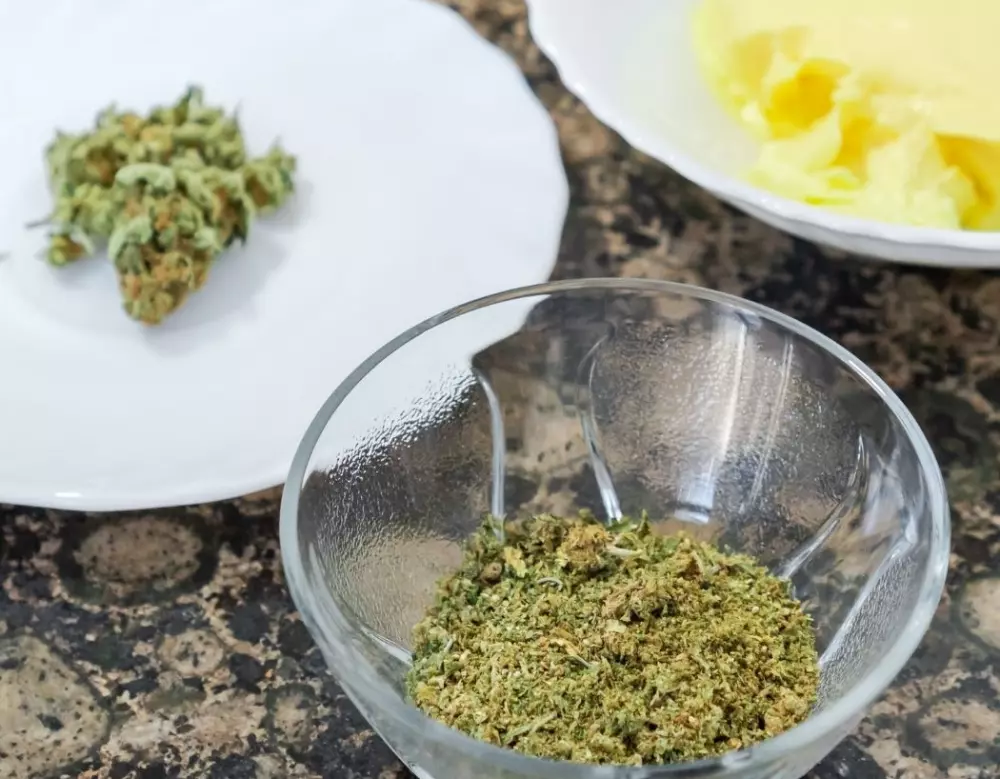Learning the building blocks of the cannabis kitchen with edibles expert and chef Rachel Burkons, with recipes for easy-to-make cannabis-infused butter and vegan cannabutter!
It’s a well-known secret in the hospitality industry that the dishes you enjoy at your favorite restaurants contain way more butter than you think they do. This is because butter is delicious: it adds richness, creaminess and saltiness to dishes. It can be used in baking or sautèeing. It’s spreadable, sweet and savory all at once.
Because butter is such a key cornerstone in cooking, it’s also the most basic building block of your cannabis kitchen. Making cannabis-infused butter is the perfect starting place if you’re looking to explore making infused foods at home, because you can really turn anything you’d normally cook with butter into an edible. Pastry recipes like brownies and cookies that call for lots of butter are a perfect fit, but savory cannabutter-topped potatoes or pastas can take your dinners from dull to delightful!
Notes On Making Cannabutter at Home
There are several methods for making cannabutter, but there are a few universal truths to keep in mind no matter your method or recipe:- Step one: decarb your product Read our full guide to decarboxylation here, but here’s a quick primer: Whether you’re using flower or concentrates, you’ll want to heat your cannabis to around 220-degrees for 45 minutes or so. There are a lot of different ways to do this process, so click through to learn more!
- Color and flavor will vary depending on your infusion method You may have seen a wide variety of colors in cannabutters, ranging from creamy light green, to dark and dank-looking. This green color is derived from chlorophyll and other compounds stripped from the plant during the infusion process. Differences in color and flavor are dependent on how the cannabutter is made or how long it is infused, and can range from just a kiss of cannabis, to full on weedy. Using an extract in your infusion will create a lighter flavor profile than using flower. While you may find some recipes calling for hours-long infusions, at a certain point the cannabinoids in the plant material are spent and you’re only bringing out bitter green flavors and colors. Some “classic” recipes may also call for the decarbing step to be done in the butter, but we do not recommend that method for optimal flavor (use the oven decarbing method!)
- Consider dosing when consuming Always take care with dosing when consuming homemade edibles! If using cannabutter in baking, I like to infuse the same amount of butter as the recipe calls for so there’s no doubt about how much THC is in the cake (or dividing the total milligrams by the number of brownie squares!). If you have a potent batch of cannabutter and you want a lower dosage in your recipe, swap out half of the infused butter for non-infused butter, and count your milligrams closely. One gram of cannabis flower is equal to 1,000 mg, so if your flower is 22% THC, you can capture 220 mg. THC per gram of flower means you really don’t need a lot of flower to create potent snackables.
Easiest-Ever Cannabis Butter Recipe
This classic recipe produces a perfect batch of cannabis butter you can use for baking, frying, or simply spreading on a piece of toast!- Your desired dose of decarbed cannabis
- 2 sticks of unsalted butter
Simple Vegan Cannabis Butter Recipe
A modern alternative to the classic is to use cannabis-infused oil in a simple vegan butter recipe. The resulting product is creamy and spreadable with a true buttery flavor, and can be used anywhere you’d use vegan butter!- 1 cup refined coconut oil, melted
- 2 tsb cannabis-infused avocado oil dosed to your desired concentration*
- 1/3 cup unsweetened soy milk
- 1 tsp apple cider vinegar
- 1 tsp nutritional yeast
- Pinch of turmeric
- ½ tsp salt
